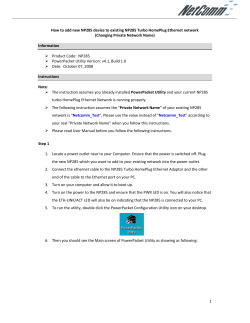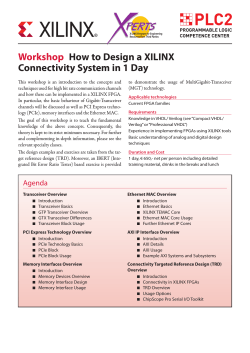
How to integrate legacy equipment into Ethernet networks Technical article
Technical article How to integrate legacy equipment into Ethernet networks As Ethernet adoption in industrial markets accelerates, there is an increasing requirement to interface legacy equipment such as meters, data-loggers, valves and flow-meters with IP networks. This article examines the 'Ethernet Gateways' that allow serial, digital and analogue equipment to be used in modern systems and how they have evolved in recent years. Serial communications Despite repeated claims that serial protocols such as RS232 and RS485 would cease to be used in industry, they are alive and well. It was believed that the removal of the RS232 port from the standard PC specification in 2000 combined with the proliferation of Ethernet and USB would sound the death knell for these legacy communication standards. However, the shear volume of serial products already in existence and the low cost and ease of integration of these legacy protocols means that serial communications are alive and well in many areas of industry. RS232 ports are usually found on mid to high volume manufactured devices, helping to keep the cost and complexity of external interfaces to a minimum. The processing power required is minimal and connectors are rugged and reliable. GPS receivers are a recent example of wide-spread RS232 adoption. Serial communications offers a low cost, low bandwidth solution for the distribution of GPS position and timing data. RS485 has been the physical layer networking solution for industrial networks since Modbus was launched by Modicon at the end of the 1970s. A robust and reliable physical layer protocol, RS485 has facilitated a generation of PLC-based master / slave networks such as Profibus DP, Modbus and INTERBUS. Modern PLC systems are primarily Ethernet based but 30 years of RS485 installations means that there is a massive installed base of PLCs capturing data that may be required in other areas of your plant or even in other parts of the world. Why would we want to integrate legacy serial equipment? Cost. Simply put - why throw away an instrument or device because it doesn’t have the right network interface? Test & Measurement equipment can be particularly costly. The lack of an Ethernet port does not warrant spending £10k on an otherwise identical piece of equipment. Data access. IP-enabling serial equipment means that data can be transmitted across a LAN, WAN or even the internet. Real-time data access can be used to make business decisions in a way never previously possible. System down-time. It may not be possible to remove legacy equipment because it is running a critical process. Instead, it can be integrated into a modern network providing the benefits of a networked solution and avoiding costly system down-time. Amplicon.com IT and Instrumentation for industry Sales: +44 (0) 1273 570 220 Website: www.amplicon.com Email: sales@amplicon.com Technical article Image 1: “A typical device server” How do we integrate legacy serial equipment? The serial to Ethernet converter, also known as a ‘device server’ or ‘terminal server’ has emerged in the last 10 years as an immensely popular tool for connecting legacy serial equipment to IP networks. A wide range of device servers with varying capabilities now exist in a global market worth hundreds of millions of pounds. A device server is typically a metal box with one or many serial ports (RS232 or RS422/485) at one end and an Ethernet port at the other. The serial device attaches to the device server and the composite unit effectively becomes a serial device with an IP address, allowing it take part in a 10/100/1000Mbps Ethernet network. Fibre-optic variants permit long-range connections, potentially up to 40km or more. If the internet is used as the connecting media, the distance limit increases to the circumference of the earth! Once connected to the network, the serial traffic passes as data to the TCP or UDP layer then on to a destination IP address. The target device is usually a PC although another device server at the far end can be used to simply reverse the serial data encapsulation process – what goes in one end comes out of the other. Paired connection such as this is referred to as ‘serial tunnelling’ and allows IP networks to be used to transfer serial data. This avoids the cost of installing new runs of serial cable. When a PC is used to receive the networked serial traffic, a direct network connection to a custom application is possible. This can be achieved by setting the device server as a client and the PC software as a server (or vice-versa, once the connection is established TCP maintains a bi-directional ‘virtual circuit’) allowing serial data to pass from the serial device directly into the application software. Client / server operating mode is ideal for OEMs & system integrators that have the ability to write custom software allowing the device server to be seamlessly integrated into existing management software. Amplicon.com IT and Instrumentation for industry Sales: +44 (0) 1273 570 220 Website: www.amplicon.com Email: sales@amplicon.com Technical article Device servers would not have proliferated so rapidly if custom software were required for every application. In fact, 90% of the device server sales at Amplicon result in the unit being used in the ‘Virtual COM’ mode of operation. A virtual COM driver is installed onto a PC which makes the networked device server’s serial ports appear as if they were installed on the local PC. This software innovation is the key to the device server’s success because it allows existing COM-port based software to be used with device servers even though the unit itself could be on the other side of the world. Advances in Serial to Ethernet technology Secure data transfer In the past, device servers operated without encryption leaving data vulnerable, especially when sent across the internet. Secure Socket Layer (SSL) is now used to implement encrypted end to end connections. SSL is the same technology used in browsers for on-line banking and is highly secure. Port buffering A major step forward for device servers is the ability to act as a serial data buffer. If the network connection is lost, serial data continues to accumulate in the device server until the connection is re-established. By using a 2GB SD RAM memory card, it is possible to increase the buffer size allowing several days worth of serial data to be collected. A port buffering feature is ideal when operating across wireless networks that occasionally lose connection. TCP will guarantee delivery of data across the network and port buffering will capture serial data and store it, preventing it from being lost during a brief network outage as would have happened with older style device servers. PoE Device servers are now available with 802.3af Power over Ethernet (PoE) compliant interfaces. This means that only a single data cable needs to be run to the unit during installation, saving time and cost. It could also mean that the device server can be located in an area without power available. Some products take this concept a step further and use the spare power available from the PoE source to power the serial device as well removing the requirement for power for the serial device server. Redundant ring integration Ring redundancy has become the favoured way to provide fault-tolerance in Industrial Ethernet networks. It is easy to build and to understand and brings major benefits when convincing end-users that availability of your finished system will be high. Device servers are often a key part of such systems, acting as the communications ‘glue’ between serial devices and the IP network infrastructure. This idea has been taken a step further by Communication specialists Moxa who manufacture device servers with dual Ethernet connections that enable them to take part directly in a redundant ring configuration. This saves the cost of an additional Ethernet switch and removes the additional point of failure that the switch would represent. Any baud rate On occasion, it may be necessary to connect to a serial device that does not conform to standard serial baud rate settings such as 9600bps or 115.2kbps. Device servers can now provide any baud rate setting up to 1Mbps. This is especially useful for non-standard or specialist devices. Amplicon.com IT and Instrumentation for industry Sales: +44 (0) 1273 570 220 Website: www.amplicon.com Email: sales@amplicon.com Technical article What about legacy devices with digital and analogue outputs? In recent years, Ethernet gateways have emerged to provide digital and analogue to IP conversion. They operate in a conceptually similar way to a device server. This type of product, generically referred to as ‘distributed I/O’ or ‘remote I/O’ modules originally operated on an RS485 back-bone to capture and distribute 0 to 10V, 4 to 20mA, TTL, relay and other similar signals. Both PC to module and module to module communications are possible. At Amplicon we have seen a major shift towards distributed I/O modules that use Ethernet for communications. In both serial and Ethernet based I/O modules, the method of data collection is typically as follows - the PC (master) sends a request to a passive remote I/O module asking for readings on the relevant input channels. In response, the addressed module sends a reply with the requested data. Whether this is done over RS485 or Ethernet, the time to respond can be up to 1 second depending on the number of channels the master must scan. Next generation I/O modules are able to send a message to the host PC as soon as a change of state occurs or an analogue trigger condition is met. Not having to be polled first, the information is effectively real-time. These I/O modules can use SNMP traps allowing information about the status of digital or analogue devices to be easily integrated into existing SNMP software deployments. Alternatively, custom software can be written to talk directly to the Ethernet I/O modules around the plant, which in turn communicate with the digital and analogue devices as required. Onboard logic functions are another extension to the basic distributed I/O concept. Using AND / OR / IF commands it is possible to build an intelligent stand-alone system performing control tasks at a low-price and without the complexity of ladder logic style programming required by most PLCs. Image 2: “A typical Ethernet based distributed I/O module” Amplicon.com IT and Instrumentation for industry Sales: +44 (0) 1273 570 220 Website: www.amplicon.com Email: sales@amplicon.com Technical article Everything over IP “Ethernet and TCP/IP are the communications protocols of the future for industrial applications.” As this idea has crystallised, manufacturers around the world have made products capable of sending dissimilar types of signal or protocol over IP. In this article, we have limited the discussion to Ethernet gateways that are most effective for integrating legacy devices, but this is only a fraction of the options available to those building Ethernet based automation systems. The surveillance market uses video over IP. Intercom manufacturers take advantage of audio over IP. GPIB over IP is a possibility for those working with test systems. Distribution of Automotive diagnostic data can be achieved with CAN over IP. Voice over IP is revolutionising the Telecommunications world. So the next time you have a project to complete, think carefully about the most easily integrated, expandable and cost-effective solution and you are likely to think – ‘Everything over IP’. If you have a project that requires integration of legacy devices into modern networks, do not hesitate to contact Amplicon’s technical team on 01273 570 220 or email sales@amplicon.co.uk. Amplicon.com IT and Instrumentation for industry Sales: +44 (0) 1273 570 220 Website: www.amplicon.com Email: sales@amplicon.com
© Copyright 2025










